
The Hottest Career in Enterprise Tech: SaaS Manager
Table of Contents ToggleHow Does Your Organization Define SaaS Management?On Becoming...
Back
Back
Search for Keywords...
Blog

Table of Contents
In 2025, SaaS spending is projected to grow 19% to total $299B, according to the analysts at Gartner. Software as a service has undoubtedly become the face of modern software as more companies divest themselves of server-based server deployments and embrace the advantages of the cloud and subscription-based access.

But these advantages – including lower pricing, easier user accessibility, more specialization, and faster time to value – do not come without a few tradeoffs. Namely, the democratization of software made possible by SaaS threatens some of the best practices for value optimization, data security, and overall IT governance that took technology leaders decades to establish.
If your desired business outcome for this year includes wrangling unmanaged tech stack growth in the shape of SaaS, take a look at these stats to aid a critical understanding of the impact subscription software.
SaaS portfolios have become bloated with apps after years of ungovered purchasing. In 2024, the average company held 275 applications in its portfolio, based on the findings in the 2025 SaaS Management Index. While this figure has come down in recent years, it’s the far less than the over 300 apps we saw in 2021.
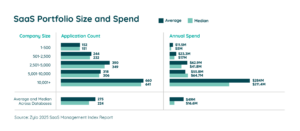
The sheer quantity of apps makes it challenging for IT to manage. What’s more alarming, however, is the SaaS sprawl. On average, companies have 7 new apps entering their environment each month. If left unmanaged, that would result in 33% portfolio growth annually.
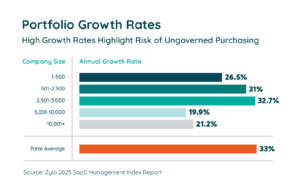
Unfortunately, decentralized purchasing makes SaaS Management a challenge. Today, 84% of applications and 74% of spending sits outside of IT’s responsibility. This trend is expected to continue. While budget sourcing for technology purchases may be shifting to lines of business, the overall responsibility for technology strategy remains squarely with IT and software asset management teams. As a whole, businesses need must take note of the impacts created by modern software and devise new strategies and processes for maximizing its effectiveness and value while mitigating risks.
When you consider that the average company holds about 275 subscription-based applications, the next question may be, how do they acquire all these tools? As mentioned above, technology spending is increasingly moving away from IT and towards lines of business, especially for applications.
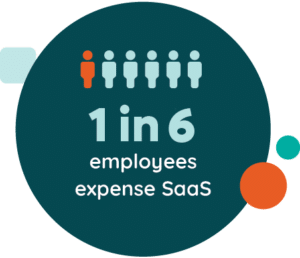 But what may be surprising is how much of this LOB spending occurs at the individual employee level. One in fifteen employees (6.6%) purchased a SaaS application using an expense process, typically a personal credit card that was then reimbursed by the company’s expense system.
But what may be surprising is how much of this LOB spending occurs at the individual employee level. One in fifteen employees (6.6%) purchased a SaaS application using an expense process, typically a personal credit card that was then reimbursed by the company’s expense system.
These purchases add up. According to Zylo data, one-third of all applications in the typical tech stack is comprised of tools purchased via employee expense. Without the ability to discover these purchases frequently, employee-led spending creates a significantly ungoverned and insecure portion of tech stack.
As it stands nows, most IT leaders underestimate the total quantity of applications in their portfolios by nearly 2X. Employee-led acquisition plays an active role in this tendency to underestimate application quantity. For example, Zylo analysis of employee-led spending on SaaS applications finds that 51% of all transactions involving SaaS were not accurately attributed to software spending.
Anecdotally, Zylo SaaS consultants frequently find SaaS transactions hidden in a wide range of seemingly innocuous expense types. That often includes meals and dinners, professional training and development, association dues and membership, and periodical subscriptions.
Because SaaS is so ubiquitous, businesses now need a tool like Zylo to accurately discover, identify, and ultimately manage applications – no matter acquisition source.
In most organizations, performance is a crucial indicator of value. That said, the ability to observe each application’s actual usage by end-users can be phenomenally essential to understanding the application’s total cost of ownership and, therefore, value.
So the fact that 53% of all SaaS licenses go unused in an average 30-day period highlights that a large portion of the cost associated with SaaS tools is wasted. In fact, on average, those unused licenses amount to $21M in wasted spend annually.
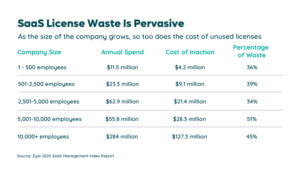
If business or IT leaders could either rightsize the number of licenses needed or, alternately, ensure all licenses become utilized, the investment in the subscription could be optimized. In most organizations, the former is more accessible than the latter.
Why do SaaS licenses go underutilized? First, many applications remain hidden or misattributed, as discussed above. That means they may escape the attention of a business leader or IT specialist charged with driving effective utilization. More often, however, the license quantities don’t match the actual need.
To truly optimize value, business and IT leaders must wrangle not only the bigger picture of applications within their environment but also end-user utilization.
SaaS renewals represent one of the central strategic challenges of managing SaaS as a business tool. This is especially true given the large quantity of renewals each year—247 on average, or one per business day. Lack of visibility or discovery into exactly when SaaS applications will be renewed under an automatic renewal clause frequently leads to unplanned renewals and subsequent unforeseen costs.
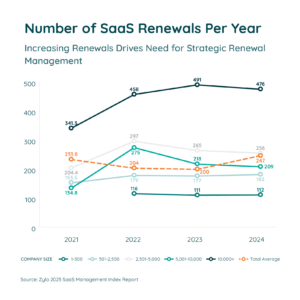
Automatic renewal clauses are a feature of SaaS agreements, not a bug. The predecessor to SaaS, on-premises software, relied on perpetual licensing – once you purchased the software, you owned it. But subscription-based software comes with distinct periods of ownership typically reinforced through renewals.
The prescription to avoid an unplanned renewal is to build a calendar that tracks all software subscription renewal dates and their related notification periods. Locating these dates and specific notification terms frequently requires tracking down the original contracts, agreements, or purchase orders and logging that information in a SaaS renewal calendar.
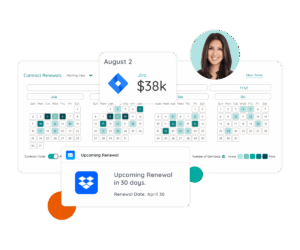
Once a timeline of renewals becomes established within a calendar, that calendar becomes a powerful tool for proactive planning. Should the application be kept, or off-boarded? How many users use the tool? Does it make sense to continue to invest in this tool, or should we shop the market for a new solution? With renewal dates and notification periods visible, these questions can be answered, and renewals can be strategically and proactively planned, instead of being reacted to.
When you add the total cost of cloud-based software and divide it by the number of employees, the result can be a staggering view of per capita costs. According to Zylo’s 2025 SaaS Management Index, the cost per employee for SaaS applications average $4,830. In contrast, the cost for employers to provide healthcare insurance to the average employee and their dependents costs slightly less than $11,000 per year, according to the National Business Group on Health.
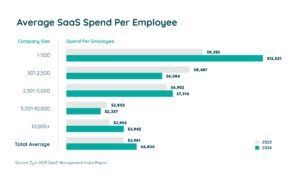
Most employers cannot operate in good faith defined strategy for employee healthcare and benefits, due in part to the high cost of the investment. If SaaS applications command nearly the same costs, shouldn’t they also command a comprehensive strategy?
There is another correlation to health benefits and SaaS investment for businesses and organizations: both affect employee experience and their ability to produce work outputs.
And increasingly, technology affects employee satisfaction and effectiveness. According to a recent survey, 92% of employees stated that having the technology necessary to do their job efficiently affects their satisfaction at work. Nearly one out of three employees in the same survey said they would quit their job if the technology at work is outdated.
With these stats in mind, IT and business leaders face a choice: Proactively develop new ways for employees to access and acquire approved software or reactively deal with shadow IT, and it’s resultant cost and risk, as it occurs.
Ready to jumpstart managing and optimizing SaaS at your organization? Request a demo of Zylo today.
2025 SaaS Management Index
Learn More
Table of Contents ToggleHow Does Your Organization Define SaaS Management?On Becoming...

Table of Contents ToggleIT Strategy Stat #1: The Average Company Has...
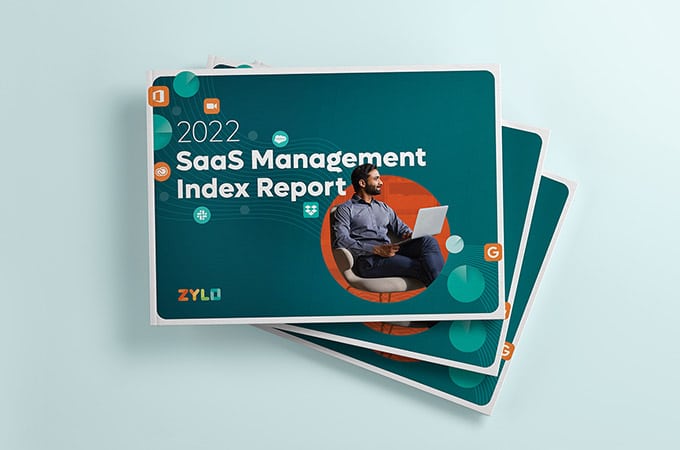
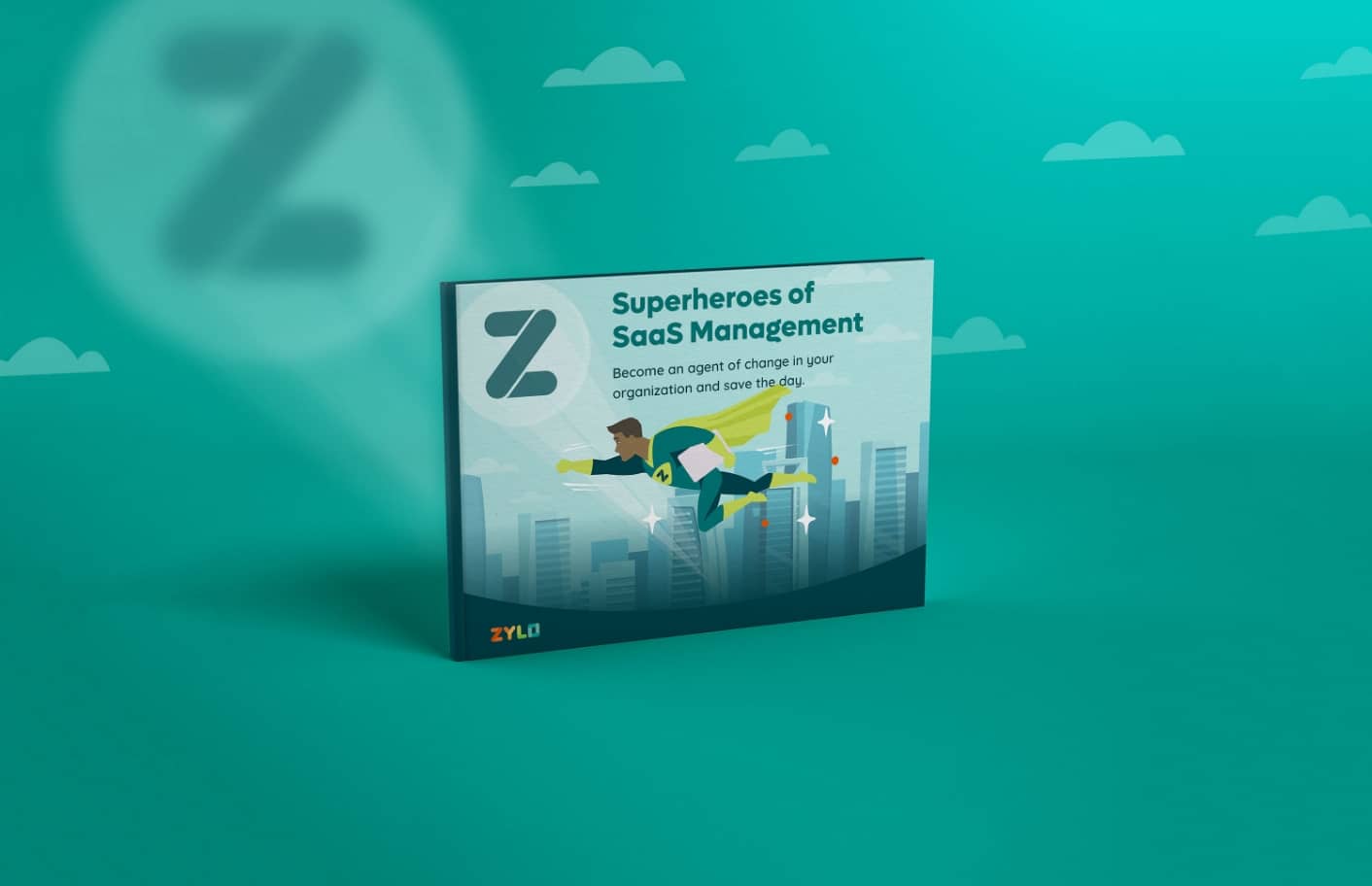
Become an agent of change in your organization and save the...
| Cookie | Duration | Description |
|---|---|---|
| cookielawinfo-checkbox-analytics | 11 months | This cookie is set by GDPR Cookie Consent plugin. The cookie is used to store the user consent for the cookies in the category "Analytics". |
| cookielawinfo-checkbox-functional | 11 months | The cookie is set by GDPR cookie consent to record the user consent for the cookies in the category "Functional". |
| cookielawinfo-checkbox-necessary | 11 months | This cookie is set by GDPR Cookie Consent plugin. The cookies is used to store the user consent for the cookies in the category "Necessary". |
| cookielawinfo-checkbox-others | 11 months | This cookie is set by GDPR Cookie Consent plugin. The cookie is used to store the user consent for the cookies in the category "Other. |
| cookielawinfo-checkbox-performance | 11 months | This cookie is set by GDPR Cookie Consent plugin. The cookie is used to store the user consent for the cookies in the category "Performance". |
| viewed_cookie_policy | 11 months | The cookie is set by the GDPR Cookie Consent plugin and is used to store whether or not user has consented to the use of cookies. It does not store any personal data. |
